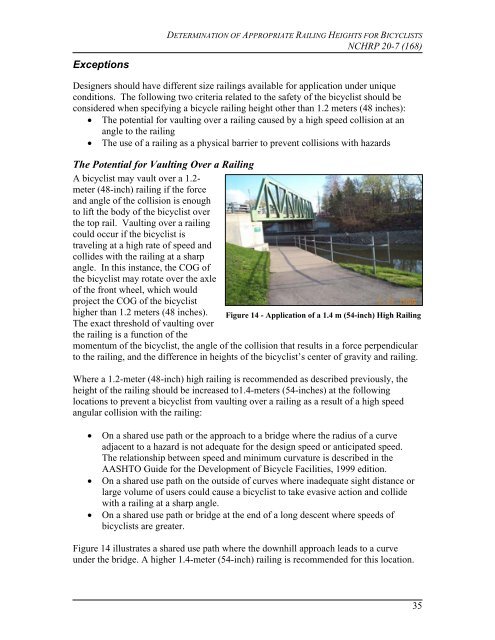Bicycle Railing Height Report - AASHTO - Subcommittee on Design
Bicycle Railing Height Report - AASHTO - Subcommittee on Design
Bicycle Railing Height Report - AASHTO - Subcommittee on Design
You also want an ePaper? Increase the reach of your titles
YUMPU automatically turns print PDFs into web optimized ePapers that Google loves.
DETERMINATION OF APPROPRIATE RAILING HEIGHTS FOR BICYCLISTS<br />
NCHRP 20-7 (168)<br />
Excepti<strong>on</strong>s<br />
<strong>Design</strong>ers should have different size railings available for applicati<strong>on</strong> under unique<br />
c<strong>on</strong>diti<strong>on</strong>s. The following two criteria related to the safety of the bicyclist should be<br />
c<strong>on</strong>sidered when specifying a bicycle railing height other than 1.2 meters (48 inches):<br />
• The potential for vaulting over a railing caused by a high speed collisi<strong>on</strong> at an<br />
angle to the railing<br />
• The use of a railing as a physical barrier to prevent collisi<strong>on</strong>s with hazards<br />
The Potential for Vaulting Over a <str<strong>on</strong>g>Railing</str<strong>on</strong>g><br />
A bicyclist may vault over a 1.2-<br />
meter (48-inch) railing if the force<br />
and angle of the collisi<strong>on</strong> is enough<br />
to lift the body of the bicyclist over<br />
the top rail. Vaulting over a railing<br />
could occur if the bicyclist is<br />
traveling at a high rate of speed and<br />
collides with the railing at a sharp<br />
angle. In this instance, the COG of<br />
the bicyclist may rotate over the axle<br />
of the fr<strong>on</strong>t wheel, which would<br />
project the COG of the bicyclist<br />
higher than 1.2 meters (48 inches).<br />
The exact threshold of vaulting over<br />
the railing is a functi<strong>on</strong> of the<br />
momentum of the bicyclist, the angle of the collisi<strong>on</strong> that results in a force perpendicular<br />
to the railing, and the difference in heights of the bicyclist’s center of gravity and railing.<br />
Figure 14 - Applicati<strong>on</strong> of a 1.4 m (54-inch) High <str<strong>on</strong>g>Railing</str<strong>on</strong>g><br />
Where a 1.2-meter (48-inch) high railing is recommended as described previously, the<br />
height of the railing should be increased to1.4-meters (54-inches) at the following<br />
locati<strong>on</strong>s to prevent a bicyclist from vaulting over a railing as a result of a high speed<br />
angular collisi<strong>on</strong> with the railing:<br />
• On a shared use path or the approach to a bridge where the radius of a curve<br />
adjacent to a hazard is not adequate for the design speed or anticipated speed.<br />
The relati<strong>on</strong>ship between speed and minimum curvature is described in the<br />
<str<strong>on</strong>g>AASHTO</str<strong>on</strong>g> Guide for the Development of <str<strong>on</strong>g>Bicycle</str<strong>on</strong>g> Facilities, 1999 editi<strong>on</strong>.<br />
• On a shared use path <strong>on</strong> the outside of curves where inadequate sight distance or<br />
large volume of users could cause a bicyclist to take evasive acti<strong>on</strong> and collide<br />
with a railing at a sharp angle.<br />
• On a shared use path or bridge at the end of a l<strong>on</strong>g descent where speeds of<br />
bicyclists are greater.<br />
Figure 14 illustrates a shared use path where the downhill approach leads to a curve<br />
under the bridge. A higher 1.4-meter (54-inch) railing is recommended for this locati<strong>on</strong>.<br />
35


